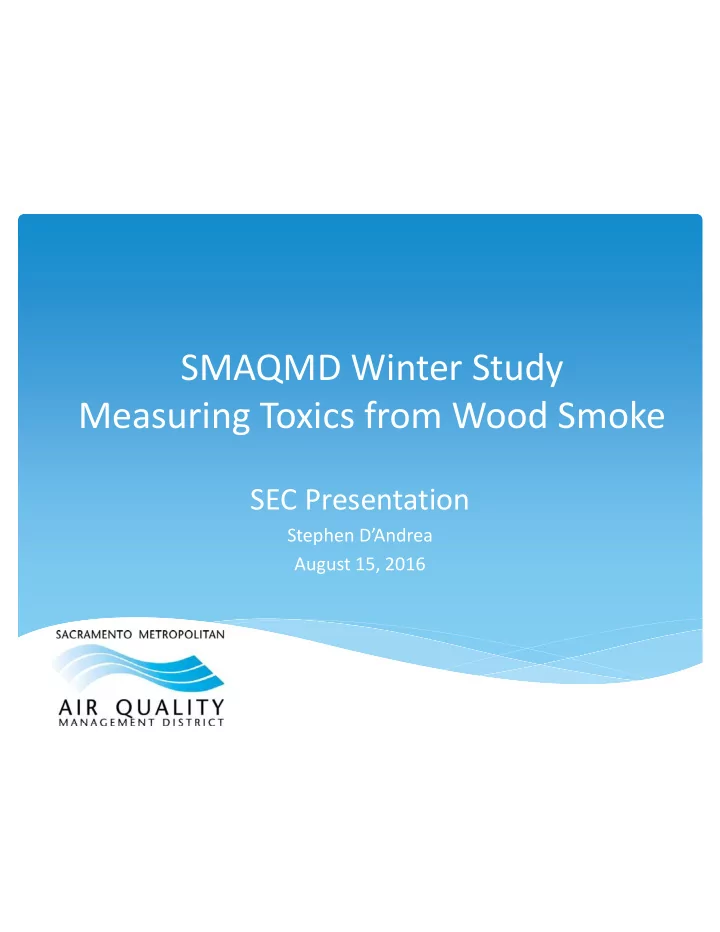

SMAQMD Winter Study Measuring Toxics from Wood Smoke SEC Presentation Stephen D’Andrea August 15, 2016
Introduction • Impact of reducing particulate-matter pollution • Purpose of studying toxics from wood smoke • Existing regulatory monitoring network • SMAQMD Study details • Methodology • Community involvement • Neighborhood selection 2
PM is Bad for Your Health • Particulate matter 2.5 (PM 2.5 ) is linked to decreased lung function, aggravated asthma, irregular heartbeat, nonfatal heart attacks and early death • Wood smoke particles are included in PM 2.5 3
PM is Bad for Your Health Other Mobile Stationary 3% 5% Wood smoke makes up 61% of the PM 2.5 On-Road Mobile 11% emission inventory in Other Areawide Sources 20% Sacramento County on Wood Burning 61% an average winter day Source: CEPAM: External Adjustment Reporting Tool. SIP2016_Version_101. Access: 14 Oct 15, 10:02 a.m. 4 4
Steady Decline Since 2008… 24-hour PM 2.5 Design Value 70 PM 2.5 Concentration ( μ g/m 3 ) Check Before You Burn (CBYB) 60 50 40 CBYB 30 20 10 0 2002 2003 2004 2005 2006 2007 2008 2009 2010 2011 2012 2013 2014 2015 Year Sacramento - Del Paso Manor 2006 Federal 24-hour PM2.5 NAAQS 5
Why is SMAQMD studying air toxics from wood smoke? To gain a better understanding of air toxics from wood smoke, along with wood burning behavior in disadvantaged and non-disadvantaged communities 6
Monitoring Network • Monitoring objectives 1. Public awareness and notification 2. Demonstrate compliance with health standards 3. Support research studies • Received $360,000 grant from EPA for community monitoring of toxics from wood smoke • Winter 2016 7
What questions will this study answer for our communities? • What are the concentrations of toxics? • To what degree does wood smoke versus traffic contribute to toxics? • Are some communities disproportionately impacted by wood smoke than others? • Are there outreach efforts that could assist in reducing this toxics exposure? 8 ejscreen.epa.gov
Technical Advisory Group • Approached scientists from the following: • Provided technical feedback on study 9
Study Design Criteria • Monitoring will take place in six communities • These six communities will represent three “pairs” : • One EJ community paired with one non-EJ community • Two of the community pairs are located near existing regulatory monitors • 13 th & T Street and Del Paso Manor • Remaining pair will be south of in an area not currently covered with a regulatory monitor 10
How Were the Communities Selected? • To determine optimum locations, SMAQMD Stakeholder combined: Input • what is important to the Stakeholders, • scientific considerations, • and goals of the study Scientific Methods • Housing and demographic characteristics • Locations and coverage area • Meteorological characteristics Final • Proximity to freeways and complex terrain Community Selection • Improve outreach in the future 11
Community Stakeholder Involvement Phase 2 Phase 1 Outreach: Outreach: Neighborhood SMAQMD Grant Study Stakeholder Stakeholder Draft Group neighborhood Group selection criteria In selected Provide input on neighborhoods neighborhood to help identify selection monitoring sites 12
Many Local Groups Helped with Community Selection! 13
Three Types of Project Monitors Tier 1: Existing regulatory sites Tier 2: New temporary community sites Tier 3: New temporary tripod sites (low cost monitors) 14
TIER 1 Monitoring Sites (Two Locations: Del Paso Manor and T Street) 15
TIER 2 Monitoring Sites (Four locations to be determined) 16
TIER 3 Monitoring Sites (20 total monitors) 17
AirBeam Handheld Monitor 18
Community Participation • Volunteers will host Tier 2 and Tier 3 monitors (20-25 locations needed) • SMAQMD and Sonoma Technology (STI) will install and remove the TIER 2/3 monitor from the property • No need for volunteers to check the equipment , maintenance will be completed by study staff • Monitors are quiet , safe , and only require a regular electrical outlet • Participants will receive compensation for hosting a monitor 19
Community Outreach During the Study (Phone Surveys) • Community phone survey will be performed in communities where monitoring will occur • Characterize wood burning behaviors • Survey results will be paired with ambient data • Help to inform future community involvement and outreach efforts 20
Next Steps for the Study… • Hands-on training session late Summer 2016 • Participant Agreements late Summer 2016 • Install monitors October 2016 • Measurements/Phone Surveys to be conducted November 2016 through February 2017 • Remove monitors February 2017 • Reporting of results late 2017 21
SMAQMD Requests Input • Recommend participants? • Host monitor in your backyard?
Extra Slides
Study Communities 24
Recommend
More recommend